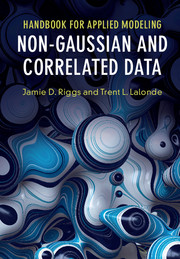Book contents
- Frontmatter
- Dedication
- Contents
- Preface
- 1 The Data Sets
- 2 The Model-Building Process
- 3 Constant Variance Response Models
- 4 Nonconstant Variance Response Models
- 5 Discrete, Categorical Response Models
- 6 Count Response Models
- 7 Time-to-Event Response Models
- 8 Longitudinal Response Models
- 9 Structural Equation Modeling
- 10 Matching Data to Models
- Bibliography
- Index
2 - The Model-Building Process
Published online by Cambridge University Press: 03 August 2017
- Frontmatter
- Dedication
- Contents
- Preface
- 1 The Data Sets
- 2 The Model-Building Process
- 3 Constant Variance Response Models
- 4 Nonconstant Variance Response Models
- 5 Discrete, Categorical Response Models
- 6 Count Response Models
- 7 Time-to-Event Response Models
- 8 Longitudinal Response Models
- 9 Structural Equation Modeling
- 10 Matching Data to Models
- Bibliography
- Index
Summary
Introduction
Model types vary widely depending on the type of data under consideration and the purpose of an investigation or analysis. In this chapter we give a short introduction to the statistical models used in this handbook. The reader may go directly to the chapter on how to use the model of interest. However, as the reader becomes more adept in model application, this chapter will be useful for acquiring additional model knowledge, and for finding literature to enhance the flexibility of and appreciation for the various models discussed.
Models, either empirical or mechanistic, allow us to gain insight into usually complicated processes. Models are used to represent particular aspects of a hypothesis, study subject, or process. As examples, a toy airplane represents the overall concept of a type of flying machine as it has the general shape and appearance of an aircraft. A hobby plane may represent intricate appearance details of a specific plane, but does not fly. A flying model may have the general appearance of a particular aircraft, but it generally lacks details of actual airplane appearance and instead is optimized specifically to fly. Then there are simulators which do not fly but allow for a facsimile of flight with performance characteristics intended to mimic the actual flying machine to train pilots.We see from these examples that each model has a different purpose, each with different relative advantages and disadvantages.
Models, then, have deficiencies relative to the object or process they represent. However, models do provide insight into a particular aspect of these objects or processes, and thereby they are useful. Models of gravitational attraction are mechanistic as nature dictates the functional relationship between, say, two masses. Stochastic or empirical models are often used to discover functional relationships among variables. They are used to provide summary information about sets of data. While it is possible to examine each observation in a data set, as the size of the data set increases, it is evermore difficult to assimilate the information held by each datum. A model matched to the data set can reveal processes and functional relationships otherwise inaccessible to individual observational examinations.
- Type
- Chapter
- Information
- Publisher: Cambridge University PressPrint publication year: 2017



